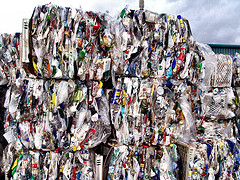
If your breakfast consists of eggs, toast, a yogurt, a mineral water and a straw, by 8am you’ve already encountered five different types of plastic; and then if you can’t muster up the appetite for it all, you might use two more plastics to preserve it in Tupperware or cling wrap. America’s plastic recycling habits may be on the rise, but there are still many perils to polys of which many of us are unaware.
Plastics are numbered from 1 to 7 depending on their composition, and can usually be determined by looking at the bottom of the package.
- #1 PET (Polyethylene terephthalate): Carbonated drink containers, water bottles, oven-ready meal containers. Recycled into: clothing and carpets, beverage containers, luggage.
- #2 HDPE (High-density polyethylene): Milk bottles, detergent bottles, food tubs, cereal box liners, grocery bags. Recycled into: nonfood containers such as bathing and laundry bottles, pipes, buckets, crates, flower pots, film, recycling bins, floor tiles.
- #3 PVC (Polyvinyl chloride): Cling wrap, loose-leaf binders, plastic pipes, medical tubing, vegetable oil bottles. Recycled into: packaging, paneling, gutters, mud flaps, film, traffic cones, garden hoses, electrical equipment.
- #4 LDPE (Low-density polyethylene): Dry-cleaning bags, trash can liners, bread bags, squeezable bottles such as mustard or honey. Recycled into: shipping evelopes, plastic lumber, film, compost bins, trash cans.
- #5 PP (Polypropylene): Ketchup bottles, medicine bottles, drinking straws. Recycled into: Automobile battery cases, brooms, brushes, ice scrapers, traffic lights, bicycle racks.
- #6 PS (Polystyrene): Cups, plates, cutlery, egg cartons, packing peanuts. Recycled into: thermostats, light switch plates, vents, rulers, license plate frames, dishware.
- #7 Other (often Polycarbonate, PC): Three- and five-gallon water jugs, food containers, Tupperware.
Because plastics are made up of molecular units which can be separated and reconstructed, there is a strong market for post-consumption plastic. The easiest plastics to break down are #1 and #2, though people recycle these only about 20% of the time, followed next by #5, which is usually only recycled 10% of the time. Only about 30% of U.S. cities have the technology to recycle #5 plastics, and the rest of the time these plastics find their thousand-year fate in landfills decomposing.
Furthermore, even the seemingly harmless #1-recyclable water bottles are becoming arguably unsafe. Two German ecotoxicologists recently discovered that PET, one of the safer plastics as cleared by the U.S. Food and Drug Administration, releases significant amounts of estrogen into its contained food or liquid. The amount leached out of the bottle depends on temperature and storage conditions, but as 95-96% of water bottles are made of PET plastic this presents a new problem in plastics.
Plastic production is up, but recycling rates are down. Recycling your water bottle is just one way to help lower the 80% that end up in landfills, but there are also other measures you can do to make a difference:
- Find out about your community’s recycling plans: Learn which plastics you can recycle properly in your town, and then try to substitute non-recyclable purchases with recyclable ones.
- Give preference to products that are made from recycled materials: look for items that read “made with recycled content” or “made with post-consumer recycled content” so that you can reuse what you recycled just weeks before.
- Reuse your plastics: plastic containers can be reused to hold leftovers, and don’t be afraid to get creative and make candy wrapper crafts.
- Reduce as much as you can: try to cut down on the overall amount of plastics you use; there are plenty of alternatives such as reusable shopping bags and drink containers that can largely diminish waste.

